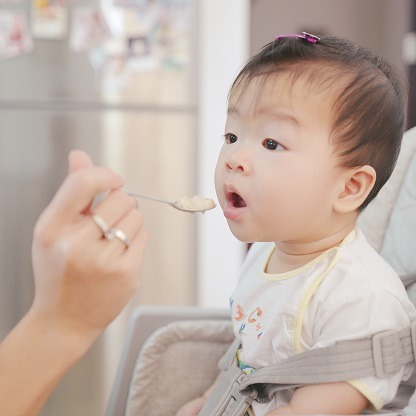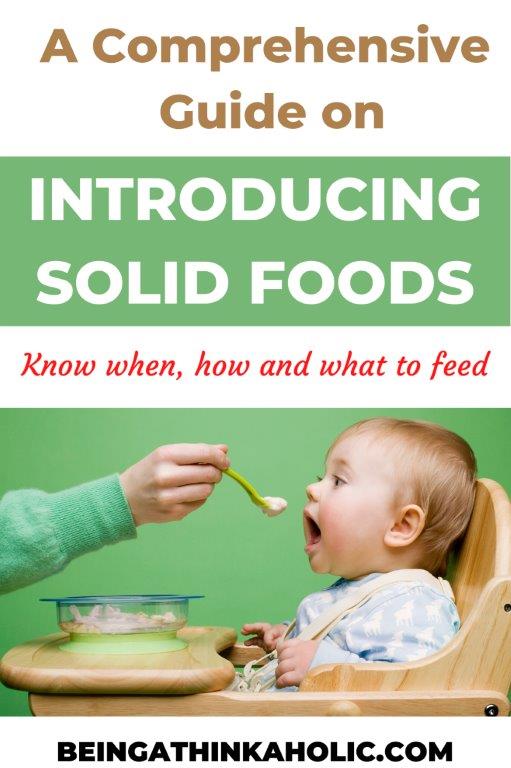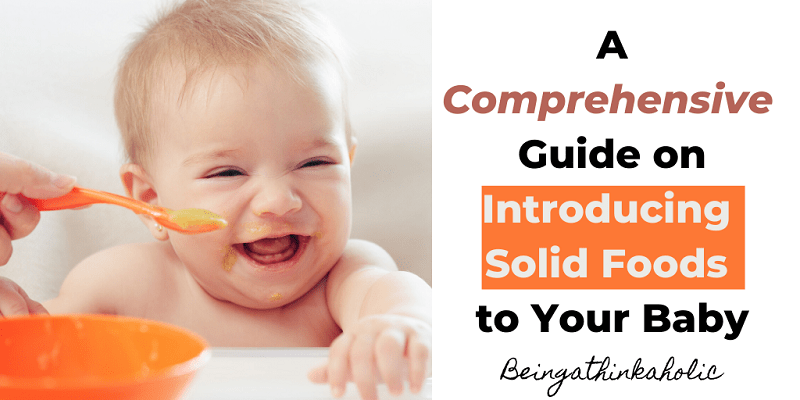The first year of parenting is full of milestones and parents look forward to each one of them. Introducing solid foods to your baby is one of the most exciting milestones. This mainly because one knows approximately when to give baby food, unlike the other milestones which the baby decides what to do and when to do. Also, moms feel they will need to feed less and will be freer.
Though the former is true, I am not sure of the latter. Why do I say this? Read on to know more and we will come back to this point.
Table of Contents
Take the Cue from Baby When Introducing Solid Foods
Doctors worldwide advise that the baby should be exclusively breastfed for the first 6 months. For those (like me) who are not able to exclusively breastfeed, they can use formula but no solids should be introduced and not even water.
Though experts and pediatricians suggest that solids should only be introduced at 6 months, my advice is to take the cue from the baby and do not follow the calendar.
Why do I say this? When Little Miss A was 5 months old she started getting up at the middle of the night for a feed. (Yes, I was lucky she slept through the night since she was 3 months old). I initially thought it was a growth spurt but as the frequency increased I was worried.
On my next visit to the pediatrician, I discussed the issue with him. He advised that it was now time for introducing solid foods. She was a few days short of 5.5 months then. He explained the milk was not keeping her full and gradually we have to increase solid foods as her body needed it now.
This was my experience but some babies do not take easily to solids at 6 months and the process of introducing solid foods needs to be delayed. For any confusion in this matter, you must take advice from your pediatrician.
Signs for The Baby’s Readiness
The baby can be ready for solids from any time after 4 months to 6 months. There are some clues that you can look for and then discuss with your doctor. Some of the ways in which the baby shows readiness are:
- The baby shows interest in the food the family is eating. They can look intently or try and grab things.
- The baby can hold their head up
- Look at the baby carefully and if he is able to make movements with the tongue, you are good to go.
- Babies have a thrust reflex and this should disappear when you are introducing solid foods to your baby
- The baby can open the mouth wide
- Has approximately doubled their birth weight

When to Give Baby Food and How Much
Now let us come to when to give baby food. Experts say to wait as close to six months as possible though babies usually get ready between 4 and 6 months. Like many other parenting decisions, this one is also about balance.
If the baby is introduced solid foods early, there are chances of allergies and if you wait longer to say about 8-9 months, they might not take easily to it. Doctors say that the enzymes in the intestine of the baby are not there which might pose problems if food is introduced earlier. Also, research shows that babies who start eating early have higher chances of obesity later.
How much food to give when giving solids is another important question. I started with a spoon of the puree and gave the same for three days at the same time. When to give baby food depends on each mom.
One thing all moms should know, when you are starting solids, the idea is to get them accustomed to the concept and create a taste. They will still fill their tummy from their milk so the portions have to be small. This is what I said in the introduction. Feeds will not reduce instantly and the baby will continue to have milk the same way.

The Timing
I introduced the solid between two feeds. By the time Miss A was ready to start solids, her milk feeds were more or less fixed. The food was to complement the feeds and not replace it. So let us say she had milk at 11 am I tried to give solids around 12-12:30 pm so that she could be ready for her next feed before her afternoon nap.
Another approach is to give solids to the baby after a feed. This suits the concept of baby led weaning as well and here the food is given to the baby to self-feed.
My pediatrician had recommended one meal a day for the first month, then graduate to two meals in the second month and then start three mails. The quantities also increased gradually. Around 10 months, Miss A enjoyed her lunch the most and stopped her afternoon milk.
She stopped breastfeeds around the same time and when she turned 1, I stopped her bottle at night too. With that, she stopped her night feed and was having her food properly. We slowly weaned her off the bottle completely and she started having her milk twice a day which she continues until date.
Each child is different and also it is a child and mother’s decision till when they want to breastfeed. It is absolutely ok to feed for as long as possible. The only thing is the bottle should be stopped between 12-18 months as that increases the chances of ear infections. Read my post on Ear Infection in Infants to know more about this painful infection. However, that also is a personal decision and, moms need to be careful.

The Best First Foods for Baby
There are a few options which are available to parents when they are introducing solid foods to their baby. The main thing that must be kept in mind is that the food should be easy to digest and must have a smooth and dropping texture. The texture can be thicker at around 8 months when the baby is more comfortable about solid foods.
Some of the options of first food for baby are:
Fruits
Fruits are not only yummy but easy to digest. One of the first fruits I introduced to Little Miss A was apple sauce and she loved it. Other options are bananas, pears and peaches. Avocado is another option though it must be ripe and mashed to a smooth texture.
Cereal
The first solid food for Miss A was soup of pulses. It was basically water after boiling the pulse. This commonly in the Indian subcontinent is known as ‘dal ka pani’. An iron rich cereal is a good option to introduce to the baby.
Vegetables
My doctor had advised me to start with carrots and then move to greener vegetables like peas. Miss A did not take to vegetables easily and I had to try them several times. She finally started enjoying her carrot puree.
When introducing solid foods, I started with purees as I have stated above. Another approach that parents across the world adopt is called, ‘baby led weaning’. In this, the babies are not given mashed and pureed food and instead are given pieces of solid foods which the baby can hold and can easily eat.
I had read about this approach but Little Miss A had not started holding things properly as her pincer grip was not well developed so I decided against it. She was able to hold her carrot sticks at about 8 months and then she was offered them along with her food.
Around 7-8 months more foods like minced meats, eggs (yolk only), wheat, pasta etc. can be introduced. Also around this time finger food can be introduced. I always gave Miss A some food on her high chair tray to play with or finger food to eat and this kept her busy while I fed her the rest. All moms need to figure out what works for them.

Foods to Avoid in the First Year
We have discussed which foods to introduce when introducing solid foods to your baby. What is equally or more important is to know the foods that should not be given to kids in the first year. If you have any doubts about any particular food, check with your doctor. Let us talk about some of the foods which are a big no.
Honey
Honey or any food with honey should not be given at all. Honey contains the bacteria Clostridium botulinum which though is harmless for adults is serious for kids under 1. Honey can cause botulism which has serious effects like dehydration, constipation, pneumonia and poor appetite apart from other things.
Egg White
This is something my pediatrician had told me and I stuck to it. He said that till Miss A was one we should not give her egg whites to avoid any allergies in the future. The egg yolk has hardly any allergens. The egg white is rich in protein and can cause allergies. If your child is allergic to eggs, they will usually outgrow it till they are 5.
Cow’s Milk
Till the baby is one-year-old, they should only be given formula or breast milk. Cow’s milk has enzymes which the baby cannot digest and it also has some minerals which can affect the kidneys. More importantly, all the nutrition that a baby requires in the first year is not available in cow’s milk and thus, they should only have the milk they have been having. i.e. breastmilk or formula.
Citrus Foods and Juices
In the first few months of introducing solid foods, no juice should be introduced and also citrus fruits should be avoided. These can cause acid reflux and an upset tummy as these are high in Vitamin C.
Shellfish
Shellfish can cause allergies and so can seafood sometimes. Discuss with your pediatrician before introducing boneless fish but shellfish should be avoided in the first year.
Foods with Choking Hazards
Foods that the baby cannot mash with their gums or can be sucked in easily should be avoided. There are foods that do not dissolve easily and can cause choking hazards. Some foods are:
- Whole nuts
- Whole grapes
- Peas (not smashed)
- Firm vegetables like bell peppers
- Big chunks of poultry
- Peanuts
The above can be gradually introduced in smaller pieces when the molars come.
Cured and Smoked Meats
Cured or smoked meats are high in animal fat, sodium and also contain nitrates which should be avoided as much as possible in the first year.

Tips on Introducing Solid Foods to Your Little One
Some tips you can follow when introducing solid foods to your baby to make it easier. I will repeat, take suggestions from your pediatrician and then see how it goes with the baby.
- Never mix two foods when introducing solid foods. You need to watch out for allergies and thus, introduce one thing at a time and give the same for 3 days. There is a 3 day rule which should be followed.
- Breast or formula milk can be combined to get the desired consistency.
- Salt and sugar must be avoided as much as possible until the baby is 1-year-old. I started adding a pinch of salt at about 9 months but no sugar till a year.
- Try and start with a iron rich cereal and then move to fruits and vegetables.
- I started with one meal a day for a month and then moved to two for the second month and from the third month started solids for all three meals.
- Solids are not primary and the baby fills up the tummy from milk. This is the time to develop tastes and introduce food so do not force feed your child.
- The first few days there will be more food on the bib and on the face, do not worry.
- The baby should be not sleepy and be in a good mood when you are introducing solid food to them.
- I started with just a spoon of the food I remember and it took ages to feed her that. Be patient and never be in a hurry to feed them.
- Ensure the baby is sitting comfortably in a chair or a high chair and is strapped to avoid them moving all over the place.
- I always gave Miss A her own spoon and some food to eat (play). This kept her busy and engaged and it was easier to feed her. It used to be messy but she enjoyed her meal time.
- I am a big supporter of silver utensils for the baby. Read my post on using Silver utensils for the baby. However, you need to be careful to not hurt the gums and also never give it to the baby. For the baby always keep a good quality silicone or plastic spoon.
- Never force feed your baby. They will move their head or stop eating when they are done and respect it.
I remember, a month after we introduced solids to Miss A she got bad diarrhea and for a few days we had to completely stop solids as she refused to eat. We did not force feed her and started again once she was better. The first 6 months of feeding have to be guided by the baby to some extent else it can backfire.
There are some products which make life easy when you are introducing solid foods. You can read my post on Must Have Feeding Essentials When You Start Weaning.

Be Careful of Allergic Reactions
It is advised that when introducing solid foods to the baby, you should try one food at a time. This is because the baby needs to acquire a taste for the food and also with the 3 day rule you can watch out for allergies. To know more about food allergies, you can read a post, All About Food Allergies in Babies.
Tips to Avoid Choking
Apart from allergies, another danger that comes with introducing solids to the baby is that of choking. Some tips to keep in mind to avoid choking when introducing solid foods to your baby are:
- Sit close to the baby and keep an eye when they eat
- Offer easy to chew in very small portions
- Try and make the baby sit straight when eating
- Avoid foods which can cause choking
If the Baby Refuses Solids
Most babies do not instantly take to solids. Some are known to take a few months. This is why it is said, this time is to introduce them to textures and food and not fill their tummies. Different options can be tried and one must try repeatedly.
Many pediatricians are of the view that when a baby refuses solid that can be an indication, their digestive system is not ready to accept food. If the baby is growing and increasing weight as per the charts, there is nothing to worry about.
Just continue to offer food and do not stop and never worry about the quantity. If the baby is not taking well to puree and feeding from spoon, try baby led weaning as many prefer to self-feed.

Happy Feeding
Introducing solid foods to the baby is a big milestone and needs some planning, practice and patience. The baby will take their time to develop a taste and enjoy the process with them. For any doubts, always consult your pediatrician. Buy a good high chair so that the baby enjoys their meal times. You can get some good options in the post, Get the Best Feeding Chair for Your Little One.
Most importantly, take the cue from the baby. They will be the guides on what, when and how to five them when introducing solid foods.
For more information on introducing solid foods and the diet of the baby, visit this comprehensive post by Medline Plus: Feeding Patterns and Diet.





Such a superb post
[…] If your baby is less than 6 months and you are thinking of introducing solids, read a Comprehensive guide on introducing solids to babies. […]